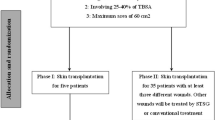Abstract
Hypertrophic scarring is still a crucial problem in burn care, especially in large burn victims who now survive more frequently. Preventative measures are needed at different time points in order to avoid further damage to residual epidermal remnants. Stimulation of reepithelialization has been carried out since 1987 in our burn centre using a combined technique of placing keratinocyte cultures on top of split-thickness meshed skin autografts. In vitro results showed that cultured keratinocyte cell extracts inhibit collagen lattice contraction. In two patient studies, an approximately two-fold stimulation of reepithelialization of meshed skin transplants was found when covered by fresh or lysated allogeneic keratinocyte cultures. No long-term effect on scar formation was found using this combined technique.
Similar content being viewed by others
References
Bell E, Ivarson B, Merril C (1979) Production of a tissue-like structure by contraction of collagen lattices by human fibroblasts of different proliferative potential in vitro. Proc Natl Acad Sci USA 76:1274
Brink JA, Sheets PW, Dines KA et al. (1986) Quantitative assesment of burn injury in porcine skin with high frequency ultrasonic image. J Invest Radiol 8:645–651
Duinslaeger L, Verbeken G, Reper P et al. (1996) Lyophilized keratinocyte cell lysates contain multiple mitogenic activities and stimulate closure of meshed skin autograft-covered burn wounds with efficiency similar to that of fresh allogeneic keratinocyte cultures. J Plast Reconstr Surg 98:110–117
Duinslaeger L, Verbeken G, Vanderkelen A (1997) Long-term effect of application of allogeneic cultured keratinocyte sheets: report of 2 cases (unpublished data)
Edwin A, Deitch MD, Timothy M et al. (1983) Hypertrophic burn scars: analysis of variables. J Trauma 23:895–898
Ewald R, Weibel G, Gonzague S et al. (1966) Practical stereological methods for morphometric cytology. J Cell Biol 30:23–28
Ferguson MWJ (1992) Fetal wound healing and manipulation of scarring in adult wound healing. In: Therapeutic advances in wound healing. IBC Technical Services, London
Germonprez P, Reper P, Vanderkelen A (1996) Hyperbaric oxygen therapy and piracetam decrease the early extension of deep partial thickness burns. Burns 22:468–473
Hoffman K, Dirschka TH, Sdicker et al. (1993) Ultrasound and cryosurgery. Dermatol Monatschr 179:270–277
Teepe RGC, Ponce M, Kempenaar JA et al. (1987) Clinical, histological and ultrastructural aspects of cultured epithelium. In: Teepe RGC (ed) Clinical use of cultured epithelium in surgery and dermatology. Medical and Scientific Conferences, Wheath-ampstead, Herts, England, pp 36–44
Shah M, Foreman DM, Ferguson MWJ (1992) Control of scarring in adult wounds by neutralising antibodies to transforming growth factor beta (TGF-beta). Lancet 339:213–214
Author information
Authors and Affiliations
Rights and permissions
About this article
Cite this article
Duinslaeger, L., Delaey, B. & Vanderkelen, A. Short- and long-term results of application of allogeneic cultured keratinocytes on burn wounds and burn scar. Eur J Plast Surg 21, 14–18 (1998). https://doi.org/10.1007/BF01152417
Received:
Accepted:
Issue Date:
DOI: https://doi.org/10.1007/BF01152417




